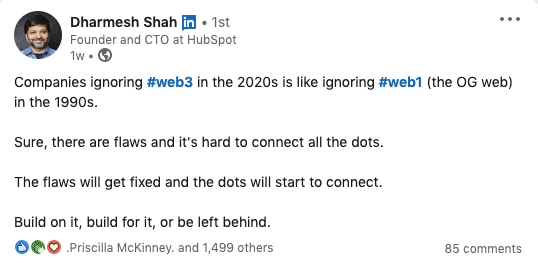The pattern is as old as plaid and paisley:
A new thing comes along.
Some people get really excited about the new thing.
Some people get over-excited about new thing and start to hype the hell out of it.
Others leap in to exploit the new thing with get-rich-quick schemes and scams.
Some people see the hype, read about the scams, watch some YouTube videos, read some tweets… and dismiss it all as either:
A) Nothing new: an old thing in new clothes
B) Stupid and not worth their time
C) A major scam perpetrated on the gullible
Well, Web 3.0 is following this pattern perfectly—and doing it all at hyper-speed and uber-scale.
My recent posts about “Web 3.0 for B2B Dummies Like Me” probably felt like premature cheerleading for blockchain/crypto/DeFi/NFTs and all that—appearing to plunk me (unfairly, I think) in the over-hype camp.
The first one, Why B2B Folks Need To Learn About Web 3.0, argued that we should all be at least learning about Web 3.0 even if we don’t actually like what we’re seeing.
The next one, 15 Web 3.0 Ideas for B2B Marketers test-drove some potential B2B uses cases as a kind of thought experiment.
This post is more about the risks of moving in too quickly.
Because, just as every action has an equal and opposite reaction, every bandwagon has an equal and opposite backlash.
Let’s take a walk down Memory Lane, stopping for a rest at Self-Congratulation Park:
Content marketing was a stupid fad
Back in 2012-ish, the idea of content marketing was just starting to happen. A lot of people (including me) were pretty excited about it. Then, into 2013-ish, it really took off—triggering the inevitable backlash.
Most of the criticism went like this: “There’s nothing new about this. It’s just a stupid name for something that’s been happening forever. It’s an over-hyped fad and it’ll go away just like every other over-hyped fad.”
In a February 2013 post called, Why The Content Marketing Backlash is Getting it Wrong, I defended the emerging discipline, arguing that, while not entirely new, the digital incarnation of content marketing was indeed a whole new thing, that it was a way better model than old-school, broadcast-style, interruptive marketing—and that it was far from a fad.
It felt weird for me to defend an over-hyped trend instead of throwing rotten tomatoes at it (I’m a natural hater), but I really felt the backlash was a lazy, knee-jerk reaction to a thing that not everyone understood yet.
Because, here’s the thing:
A backlash is just a bandwagon in reverse
Every cultural backlash exhibits the same dynamics as the hype-balloon it’s trying to pop: instant judgement based on superficial understanding; a seemingly willful mis-characterization of the enemy’s position; and a shrill superiority over the idiots who ‘just don’t get it’.
Well, probably because the hype was so huge, the Web 3.0 backlash has been a tsunami of ridicule, a tornado of disdain followed by a soaking of schadenfreude.
One of my favoruites was Mark Ritson,’s article in Marketing Week, “NFTs Are Just Marketing’s Latest Idiot Magnet“. He calls NFTs ‘a pointless fad’ and demonstrates it by minting his own NFTs—photos of himself on the toilet—and selling them on OpenSea (they’re gone now… sold?). Very funny and full of ‘ouch’ moments for anyone who owns an NFT (I do—but not the kind you think).
Another super-popular, anti-Web3 cudgel was the two-hour video diatribe by Dan Olson called Line Goes Up. It’s smart, informed, full of valid arguments and as entertaining as a guy hectoring you for two hours can be. With 7.6 million views to date, it clearly hit home for a lot of people.
There might be a baby in that bathwater
Both of these pieces—and thousands more like them—focus on the worst examples of the New Thing: the crypto scams and meme coins (like Doge or Shiba Inu); the pump-and-dump NFTs (like the Squid Game fraud); the planet-incinerating currencies (like Bitcoin and Ethernet 1); the stupid copycat projects (like… too many to mention); the celebrity-puffed, conspicuous consumption plays (like Crypto Punks and, arguably, Bored Ape Yacht Club); and, of course, The Crash (as I’m writing this most NFTs have lost 50-100% of their… I was about to say ‘value’ but I think I mean ‘price’).
Of course, looking for examples of stupidity and criminality in Web 3.0 is like looking for references to aquatic mammals in Moby Dick (metaphor stolen from Nabokov).
Let’s face it, the Web 3.0 crypto-gold rush has brought out the very worst of our species: a virtual parade of liars, braggarts, phoneys, thieves, bullies, mobs and the chronically credulous.
But it’s also attracted some of the most brilliant, inventive, creative, talented innovators on the planet. From the scientists solving the fundamental problems around things like consensus mechanisms, and transaction scaling; to the developers building the exchanges, apps, games, and platforms; to the strategists working out the new business models, DeFi plays, collectible markets and their underlying ‘tokenomics’.
So, yes, there’s plenty for the backlashers to lash back at. It’s a target-rich environment.
But there are also exciting new ideas trying to get out here. Ideas around digital ownership, ‘trustless’ transactions, and decentralization. Ideas that, with any luck, could turn legacy fatcats like HSBC and Barclays into SMBs who cheat on their taxes.
When the Internet bubble burst in 2000, the Internet sceptics (yes, there were lots) all crowed, “See? Told you so!”. Yes, a lot of shitty, over-hyped businesses were flushed out. But the fundamental power of the Internet was not disproven or exposed as a scam. An overheated hype-market just corrected itself. Over the next few decades, the hype about the Internet turned out to be understatement.
This will probably happen—maybe over a few boom-bust cycles—with Web 3.0. Every crash and collapse will be used as ‘proof’ that the whole thing is empty. But the strong ideas will survive and people will build them into a new order, eventually.
Why web 3.0 caution is probably a good bet for B2B folks right now
If you’re an established B2B company, it makes sense to learn about all this stuff. But it also makes sense to sit the early rounds out until some of the dust settles. Here’s why:
The backlash could splatter your brand
The World Wildlife Fund UK had to cancel its plans for a fundraising NFT because its core audience hated the idea. They could have tried to win over the haters but is that what you want to spend your resources doing?
And the guys behind Firefox, the Mozilla Foundation had to back away from its announced plan to accept cryptocurrency donations after an outcry by crypto-hating supporters.
Jamie Zawinski, a Mozilla founder, came out with, “Everyone involved in the project should be witheringly ashamed of this decision to partner with planet-incinerating Ponzi grifters.” Ouch.
You could stumble badly and hurt your customers
Adidas had to issue a public apology to fans who were burned by excessive transaction fees for the launch of their Bored Ape NFT collaboration. Causing your customers to lose money is not a good look.
You’ll have to invest a lot in explaining this stuff
NFTs, crypto and tokens are far from mainstream yet. Yes, there’s a Novelty Dividend from being early—but there’s also a Pied Piper Penalty. Look at how hard Gary Vee had to work to teach the world about NFTs so they’d buy a Vee Friend (he did and they did).
The infrastructure of Web 3.0 is still unstable
The infrastructure for all this stuff—the blockchains and tokens and coins—are still really science experiments. If you build on it—and promise increasing value to your customers or community members—you could get whipped around a lot.
The pioneers in Rally.io creator coins are doing impressive things, but the underlying value of the Rally token is a roller-coaster (one that mostly swoops down). And if so-called ‘stablecoins’ are an important part of your stack… the recent collapse of UST and Luna are cautionary tales amped up to 11. (“Stable” my bored ape arse).
Be careful out there
A recent LinkedIn post by Dharmesh Shah (one of the smartest guys in… anything) said, and I quote:

I agree with Dharmesh: ignoring is a bad option. But diving in may not be a better one yet.
There’s a lot more to go wrong with Web 3.0 before big things start to go right.
What will survive all this?
When all the smoke clears, a few things will still be standing.
The concept of digital owership will still be standing.
Decentralized, trustless networks will still be standing.
Smart contracts and tokens and dapps will still be standing.
NFTs may not be called NFTs but they’ll be with us forever. (Why do we let techies name stuff?)
And Web 3.0 will create thousands of opportunities—for the smart, the quick, the brave and, above all… the lucky.

Enjoyed this article?
Take part in the discussion








Comments
There are no comments yet for this post. Why not be the first?